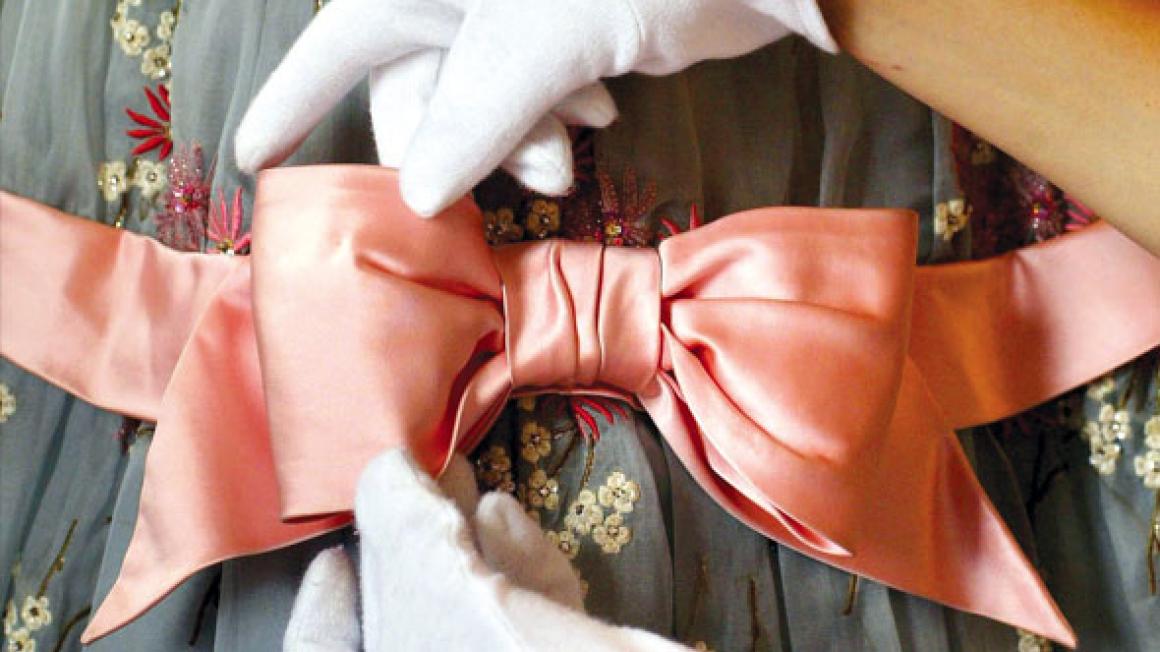HOW TO DRESS A ROYAL
If education is generally held to consist of the ‘three Rs’, fashion might be said to comprise the ‘three Cs’ – cut, colour, cloth. The importance of the harmony of these three sartorial graces is responsible for these breathtaking designs. That and also the underlying fact (not immediately obvious, perhaps) that in one sense, they are actually ambassadors and ironically, ‘work clothes’.
Indeed, intended to enhance and be memorable for state visits, ambassadorial dinners and Parliament openings, they had to have instant impact. Curated with flair by Cassie Davies-Strodder, this bijou show reminds the visitor of what constitutes haute couture and even more than that – couture by Royal commission.
 Zandra Rhodes gown worn to a banquet during a Royal visit to Japan in 1986
Zandra Rhodes gown worn to a banquet during a Royal visit to Japan in 1986Housed in small glass structures, the viewer can get up close to witness every detail and appreciate the efficacy of every stitch. The embroidery especially on some of the Queen’s gowns of the 1950s is superlative, adding not only sparkle but actually informing the very architecture of the dress itself. Norman Hartnell’s evening gown made for the Queen when she opened the New Zealand Parliament during a Commonwealth visit in 1963, is a fine example. The neat, trim lines of this oyster-hued duchesse satin gown is worked with pearls, crystals and sequins in subtle shades of tobacco and fine old champagne. The evening gown designed by Hardy Amies for the Queen in a shining pearl-grey satin, is sprinkled with intricate beaded fern motifs. Amies was granted the Royal Warrant in 1955 and famously said that a dress should never be designed without straps. The reason? ‘Men can’t help wondering how it is held up.’ No surprise then that this gown sports these essential devices.
Often it is said that simplicity is by far the best option but this belies the complexity of that seeming simplicity. A devilishly plain silk dress in electric teal with nut-brown fur trim at the neck and forearms by Norman Hartnell is a shining example of the couturier’s art. This piece was worn for the Silver Wedding Anniversary Thanksgiving service at Westminster Abbey in 1972.
 The Queen wore an embroidered ivory evening gown by Norman Hartnell to the opening of Parliament in New Zealand in 1963
The Queen wore an embroidered ivory evening gown by Norman Hartnell to the opening of Parliament in New Zealand in 1963But it is when Princess Margaret’s gowns and outfits are examined that one realises the subtlety of handmade clothes. Instantly, one can see a greater sense of freedom achieved and the whispered accents of trend.
A hugely stylish woman, Princess Margaret showed her love of experimentation, such as the rich bottle-green velvet coat dress, so now, designed by Marc Bohan for Christian Dior (1975). It was Bohan who wisely said ‘N’oubliez pas la femme’ – ‘never forget the woman (within)’ – Royal or no. And as a complete contrast, the Carl Toms 1976 kaftan and turban in diaphanous ivory folds fashioned from sari silk, transforms the princess into the English aristocrat and writer Lady Wortley Montagu or socialite Lady Hester Stanhope of her time. It was worn to that well-documented party in Mustique.
 As worn by Princess Margaret
As worn by Princess MargaretBut it is when we come to the fi nal display of the outfits worn by Diana, Princess of Wales, that we experience something of a jolt. The 1980s was indeed the decade that style forgot. Sparkles are here, but seem too brash and bold. The cuts flattered no one – even a sophisticated and beautiful woman such as she. It is only when we see the elegant and beautifully restrained and noble gown by Catherine Walker in 1991 that we remember Diana as a global style – not fashion – icon. She made the asymmetric look instantly desirable.
Exquisite covers of Vogue line the walls, giving a vintage vivacity to the show. Divinely delicious but also a sad reminder of the parlous state of most fashion today where irony is treated not as a spice but a meal in itself.
Fashion Rules: Dress From The Collections Of HM The Queen, Princess Margaret And Diana, Princess of Wales, runs until summer 2015 at Kensington Palace, Kensington Gardens, London W8: 0844-482 7799, www.hrp.org.uk


